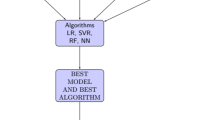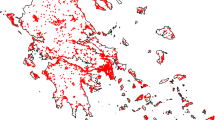Abstract
This paper addresses a property valuation problem with machine learning models with pre-selection of attributes. The study aimed to examine to what extent the environmental attributes influenced real estate prices. Real-world data about purchase and sale transactions derived from a cadastral system and registry of real estate transactions in one of Polish big cities were employed in the experiments. Machine learning models were built using basic attributes of apartments and environmental ones taken from cadastral maps. Five market segmentations were made including administrative cadastral regions of a city and quality zones delineated by an expert, and classes of apartments. Feature selection was accomplished and property valuation models were built for each division of a city area. The study allowed also for a comparative analysis of performance of ensemble learning techniques applied to construct predictive models.
Access this chapter
Tax calculation will be finalised at checkout
Purchases are for personal use only
Similar content being viewed by others
References
Chen, T., Guestrin, C.: XGBoost: a scalable tree boosting system. In: Proceedings of the 22nd ACM SIGKDD International Conference on Knowledge Discovery and Data Mining, pp. 785–794. ACM (2016)
De Nadai, M., Lepri, B.: The economic value of neighborhoods: predicting real estate prices from the urban environment. In: 2018 IEEE 5th International Conference on Data Science and Advanced Analytics (DSAA), pp. 323–330. IEEE (2018)
Dietterich, T.G.: Ensemble methods in machine learning. In: Kittler, J., Roli, F. (eds.) MCS 2000. LNCS, vol. 1857, pp. 1–15. Springer, Heidelberg (2000). https://doi.org/10.1007/3-540-45014-9_1
Erevelles, S., Fukawa, N., Swayne, L.: Big Data consumer analytics and the transformation of marketing. J. Bus. Res. 69(2), 897–904 (2016)
Fischer, T., Krauss, C.: Deep learning with long short-term memory networks for financial market predictions. Eur. J. Oper. Res. 270(2), 654–669 (2018)
Gandomi, A., Haider, M.: Beyond the hype: big data concepts, methods, and analytics. Int. J. Inf. Manag. 35(2), 137–144 (2015)
Ke, G., et al.: LightGBM: a highly efficient gradient boosting decision tree. In: Advances in Neural Information Processing Systems, pp. 3146–3154 (2017)
Kok, N., Koponen, E.L., Martínez-Barbosa, C.A.: Big data in real estate? From manual appraisal to automated valuation. J. Portf. Manag. 43(6), 202–211 (2017)
Lasota, T., Łuczak, T., Trawiński, B.: Investigation of rotation forest method applied to property price prediction. In: Rutkowski, L., Korytkowski, M., Scherer, R., Tadeusiewicz, R., Zadeh, L.A., Zurada, J.M. (eds.) ICAISC 2012. LNCS (LNAI), vol. 7267, pp. 403–411. Springer, Heidelberg (2012). https://doi.org/10.1007/978-3-642-29347-4_47
Lasota, T., Mazurkiewicz, J., Trawiński, B., Trawiński, K.: Comparison of data driven models for the valuation of residential premises using keel. Int. J. Hybrid Intell. Syst. 7(1), 3–16 (2010)
Lasota, T., Sawiłow, E., Trawiński, B., Roman, M., Marczuk, P., Popowicz, P.: A method for merging similar zones to improve intelligent models for real estate appraisal. In: Nguyen, N.T., Trawiński, B., Kosala, R. (eds.) ACIIDS 2015. LNCS (LNAI), vol. 9011, pp. 472–483. Springer, Cham (2015). https://doi.org/10.1007/978-3-319-15702-3_46
Lasota, T., Telec, Z., Trawinski, B., Trawinski, G.: Evaluation of random subspace and random forest regression models based on genetic fuzzy systems. In: KES, pp. 88–97 (2012)
Lasota, T., Telec, Z., Trawinski, B., Trawinski, K.: Investigation of the ets evolving fuzzy systems applied to real estate appraisal. Mult.-Valued Log. Soft Comput. 17(2–3), 229–253 (2011)
LeCun, Y., Bengio, Y., Hinton, G.: Deep learning. Nature 521(7553), 436 (2015)
Leung, M.K., Delong, A., Alipanahi, B., Frey, B.J.: Machine learning in genomic medicine: a review of computational problems and data sets. Proc. IEEE 104(1), 176–197 (2015)
Li, J., Tao, F., Cheng, Y., Zhao, L.: Big Data in product lifecycle management. Int. J. Adv. Manuf. Technol. 81(1–4), 667–684 (2015)
Li, J., et al.: Feature selection: a data perspective. ACM Comput. Surv. (CSUR) 50(6), 94 (2018)
Libbrecht, M.W., Noble, W.S.: Machine learning applications in genetics and genomics. Nat. Rev. Genet. 16(6), 321 (2015)
Lötsch, J., et al.: Machine-learning-derived classifier predicts absence of persistent pain after breast cancer surgery with high accuracy. Breast Cancer Res. Treat. 171(2), 399–411 (2018)
Malinowski, A., Piwowarczyk, M., Telec, Z., Trawiński, B., Kempa, O., Lasota, T.: An approach to property valuation based on market segmentation with crisp and fuzzy clustering. In: Nguyen, N.T., Pimenidis, E., Khan, Z., Trawiński, B. (eds.) ICCCI 2018. LNCS (LNAI), vol. 11055, pp. 534–548. Springer, Cham (2018). https://doi.org/10.1007/978-3-319-98443-8_49
Polikar, R.: Ensemble learning. In: Zhang, C., Ma, Y. (eds.) Ensemble Machine Learning, pp. 1–34. Springer, Boston (2012). https://doi.org/10.1007/978-1-4419-9326-7_1
Silver, D., et al.: Mastering the game of go with deep neural networks and tree search. Nature 529(7587), 484 (2016)
Sylla, M., Lasota, T., Szewrański, S.: Valuing environmental amenities in peri-urban areas: evidence from poland. Sustainability 11(3), 570 (2019)
Trawiński, B., Lasota, T., Kempa, O., Telec, Z., Kutrzyński, M.: Comparison of ensemble learning models with expert algorithms designed for a property valuation system. In: Nguyen, N.T., Papadopoulos, G.A., Jędrzejowicz, P., Trawiński, B., Vossen, G. (eds.) ICCCI 2017. LNCS (LNAI), vol. 10448, pp. 317–327. Springer, Cham (2017). https://doi.org/10.1007/978-3-319-67074-4_31
Trawiński, B., Smetek, M., Telec, Z., Lasota, T.: Nonparametric statistical analysis for multiple comparison of machine learning regression algorithms. Int. J. Appl. Math. Comput. Sci. 22(4), 867–881 (2012). https://doi.org/10.2478/v10006-012-0064-z
Trawiński, B., et al.: Comparison of expert algorithms with machine learning models for real estate appraisal. In: 2017 IEEE International Conference on INnovations in Intelligent SysTems and Applications (INISTA), pp. 51–54. IEEE (2017)
Vafeiadis, T., Diamantaras, K.I., Sarigiannidis, G., Chatzisavvas, K.C.: A comparison of machine learning techniques for customer churn prediction. Simul. Model. Pract. Theory 55, 1–9 (2015)
Voyant, C., et al.: Machine learning methods for solar radiation forecasting: a review. Renew. Energy 105, 569–582 (2017)
Webb, S.: Deep learning for biology. Nature 554(7693), 555–557 (2018)
Witten, I.H., Frank, E., Hall, M.A., Pal, C.J.: Data Mining: Practical Machine Learning Tools and Techniques. Morgan Kaufmann (2016)
Author information
Authors and Affiliations
Corresponding author
Editor information
Editors and Affiliations
Rights and permissions
Copyright information
© 2019 Springer Nature Switzerland AG
About this paper
Cite this paper
Talaga, M., Piwowarczyk, M., Kutrzyński, M., Lasota, T., Telec, Z., Trawiński, B. (2019). Apartment Valuation Models for a Big City Using Selected Spatial Attributes. In: Nguyen, N., Chbeir, R., Exposito, E., Aniorté, P., Trawiński, B. (eds) Computational Collective Intelligence. ICCCI 2019. Lecture Notes in Computer Science(), vol 11683. Springer, Cham. https://doi.org/10.1007/978-3-030-28377-3_30
Download citation
DOI: https://doi.org/10.1007/978-3-030-28377-3_30
Published:
Publisher Name: Springer, Cham
Print ISBN: 978-3-030-28376-6
Online ISBN: 978-3-030-28377-3
eBook Packages: Computer ScienceComputer Science (R0)




